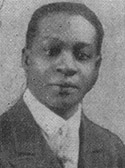Carter Walker Wesley
Born in Houston in 1892, Carter Wesley grew up in Freedmen’s Town, the city’s earliest and most successful black neighborhood. After finishing high school, Wesley moved to Nashville, Tennessee where he worked his way through Fisk University, graduating magna cum laude in 1917.
Inspired by W.E.B. Du Bois and other black leaders and writers, Wesley joined the NAACP and contemplated a career in law. World War I soon interrupted his plans. Following graduation, he enrolled in a black officers’ training camp at Fort Des Moines in Iowa. He received his commission as a first lieutenant.
At the same time, Wesley became deeply concerned over the violence that had swept through his home town of Houston and led to the court martial and hanging of black soldiers from Camp Logan. His concerns over the miscarriage of justice reinforced his interest in law.
The U.S. Army soon sent Wesley and his unit to Europe. He fought in the Argonne and Verdun regions and in the battle of Oise-Aisne. Following the war, Wesley enrolled in law school at Northwestern University in Evanston, Illinois (a suburb of Chicago).
Following his graduation from law school, Wesley joined Jasper “Jack” Atkins, a friend from Fisk and a graduate of Yale’s law school, in establishing a practice in Muskogee, Oklahoma, near Tulsa. In 1921, Tulsa was the site of one of the worst race riots in the nation’s history.
Although he prospered in Oklahoma, Wesley made plans to return to Houston in 1927 and convinced Dr. G.P.A. Forde, a physician in Muskogee, to also move to Houston because of the opportunities afforded by the Houston Negro Hospital.
In 1931, Wesley and Atkins invited another Northwestern law school graduate, James Madison Nabrit, Jr., to join their practice. In 1930, they were only 21 black lawyers practicing in the state of Texas. Wesley also invested in construction businesses, real estate, and the local African-American newspaper, The Informer. He soon took controlling interest in the newspaper. By 1945, The Informer was the largest black-owned business in Houston in terms of the number of people employed and its gross income.
As an attorney, Wesley remained active in civil rights issues. He forced the NAACP to stop relying on white attorneys to pursue cases in Texas. In the 1940s, over the objections of other activists in Houston, Wesley successfully argued for a two-prong approach to civil rights. On one hand, he pushed for the integration of white educational institutions throughout Texas. When Herman Sweatt applied for admission to the University of Texas law school, he was denied admission because he was black. Supporting Sweatt’s cause, Wesley employed him at The Informer while the lawsuit worked its way to the U.S. Supreme Court.
In an effort to forestall Sweatt’s efforts, the Texas legislature launched Texas State University (now known as Texas Southern University) and established a law school there to show that African Americans had their own separate and supposedly equal facility. Nonetheless, in 1950, the U.S. Supreme Court ruled in Sweatt’s favor, holding that there were quantitative differences in the facilities and intangible inequities in the development of professional networks. The decision in Sweatt v. Painter (339 U.S. 629 (1950)) represented a successful challenge to the “separate but equal” doctrine of Plessy v. Ferguson (1896).
Despite court victories such as this, Wesley anticipated that the integration of educational facilities in Texas and throughout the South would be a slow process. Thus, as the second part of his strategy, he continued to demand immediate improvements to and increased resources for the schools the state restricted to black students only. Other activists believed that “segregated black schools were no more than monuments of Jim Crow racism.” 1 When in-fighting erupted in the local NAACP office, Wesley, a man of no small ego, succeeded in pushing through his two-pronged approach.
The State of Texas did not mandate the elimination of race as an admissions requirement at all state institutions of higher education until 1965, some eleven years after the U.S. Supreme Court decision in Brown v. Board of Education and fifteen years after the decision in Sweatt v. Painter.
Houston lost one of its great civic leaders when Carter Wesley died in 1969. “Ultimately, the civil rights movement Wesley sounded into action modernized the southern system of racial hierarchy, helping save it from itself. The movement pushed a racial state to demonstrate obedience to the rule of law, to become less opaque, more rational and insidious…. His solution centered on black people sustaining a collective ethos of independence and self-reliance.” 2
Citations
- Amilcar Shabazz, “Carter Wesley and the Making of Houston’s Civic Culture before the Second Reconstruction.” Houston Review 1 (2004): 12.
- Ibid., 13.


